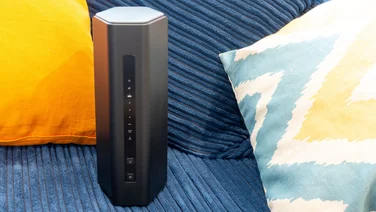To help us provide you with free impartial advice, we may earn a commission if you buy through links on our site. Learn more







- Supreme performance
- Packed with features
- Good connectivity
- Chunky design
- Relatively expensive
If you’re looking for a dinky little extender to plug unobtrusively into a wall socket, this won’t be a case of love at first sight. Standing nearly 23cm tall, the Nighthawk X6S is the size of a full-blown router – and its upright design makes it tricky to hide away under a sofa or on a shelf.
Netgear Nighthawk X6S review: Top of the class
Yet the Nighthawk X6S’ unusual size is justified by what’s inside. Most Wi-Fi extenders use a single radio to talk to both your router and connected clients: this results in constant contention, which slashes the effective bandwidth.
The X6S boasts a tri-band design, in which a single 2.4GHz radio is partnered with two 5GHz radios – one of which handles backhaul communications with the router, while the other broadcasts the extended network and deals with client traffic.
The results speak for themselves. The X6S leaves pretty much every other comparable extender in the dust. It tops the table for 5GHz performance in every area of the house, and even manages to project the full bandwidth of a 100Mbits/sec fibre broadband connection out onto my rear terrace. On the 2.4GHz band its performance wasn’t quite as stellar, but it still proved solid and consistent.







Previously, we have only seen these sorts of speed from high-end mesh Wi-Fi setups – and that makes sense because the tri-band configuration is exactly how premium mesh systems work. The difference is that here your existing router acts as the base, which makes everything cheaper and simpler.
Not that the X6S’ exceptional performance is solely down to tri-band technology. The proof of that is the cheaper Netgear X4S, which also features tri-band radios. The X6S’ little sibling gave us some speedy downloads, but the signal was clearly less able to punch through brickwork and pipes. With its bigger, stronger radios, the X6S was better able to extend a strong wireless connection into difficult areas.
Netgear Nighthawk X6S review: Connectivity
We’ve mentioned that the X6S is the size of a router and it looks like one, too. Along the front, a rank of eight LEDs gives you an at-a-glance indication of status and network activity – and at the rear there are four Gigabit Ethernet ports, so you can distribute all that bandwidth around a whole office, or hook up your smart TVs and games consoles.







Unexpectedly, there’s also a USB 2 port, which you can use to share files and folders over your home network. An impressive range of file systems is supported, with full read and write access to NTFS, Ext4 and HFS+. You can even set up user accounts and restrict access to specific shares – and enable the built-in ReadyDLNA server, so media devices on your network can stream directly from a USB share.
Netgear Nighthawk X6S review: Configuration
All of this is managed from a web interface that’s basically the same as the one you’ll find on Netgear’s routers. To access it, you simply browse to mywifiext.com from anywhere on your extended network. This brings up a multipage portal that’s loaded with technical information. You can audit and block connected clients, set up an access schedule, configure WPS PIN access – in case the physical WPS button round the back isn’t convenient – customise IP address settings and back up and restore your settings.
Here’s also where you configure SSID and band-steering settings. I like to keep my 2.4GHz and 5GHz networks separate, but if you wish, you can have the extender automatically shunt clients across bands to maintain the strongest signal. It’s also up to you whether you want the extender to use the same SSID as your main Wi-Fi network, or create a separate network.
One thing you can’t do is set up a secondary guest network, but if you’re worried about security, you can opt not to broadcast an SSID at all, so only people who know the name of your extended network can connect to it.
Netgear Nighthawk X6S review: Price and verdict
With its unbeatable combination of speed and features, the Nighthawk X6S is the clear stand-out Wi-Fi extender on the market at the moment – but it’s also the most expensive. If you just need something to fill out the signal in a remote bit of your home, you could save a lot of money by opting for the Tenda A15 or the TP-Link RE365.
If you’re looking for fast file transfers and lots of features, however, the extra outlay for the X6S is a no-brainer, netting you mesh-like speeds and coverage for basically the same price as Devolo’s Magic 1 kit. Yes, as extenders go, it’s somewhat big and boxy – but you’ll be appreciating its performance long after you’ve stopped worrying about its looks.







